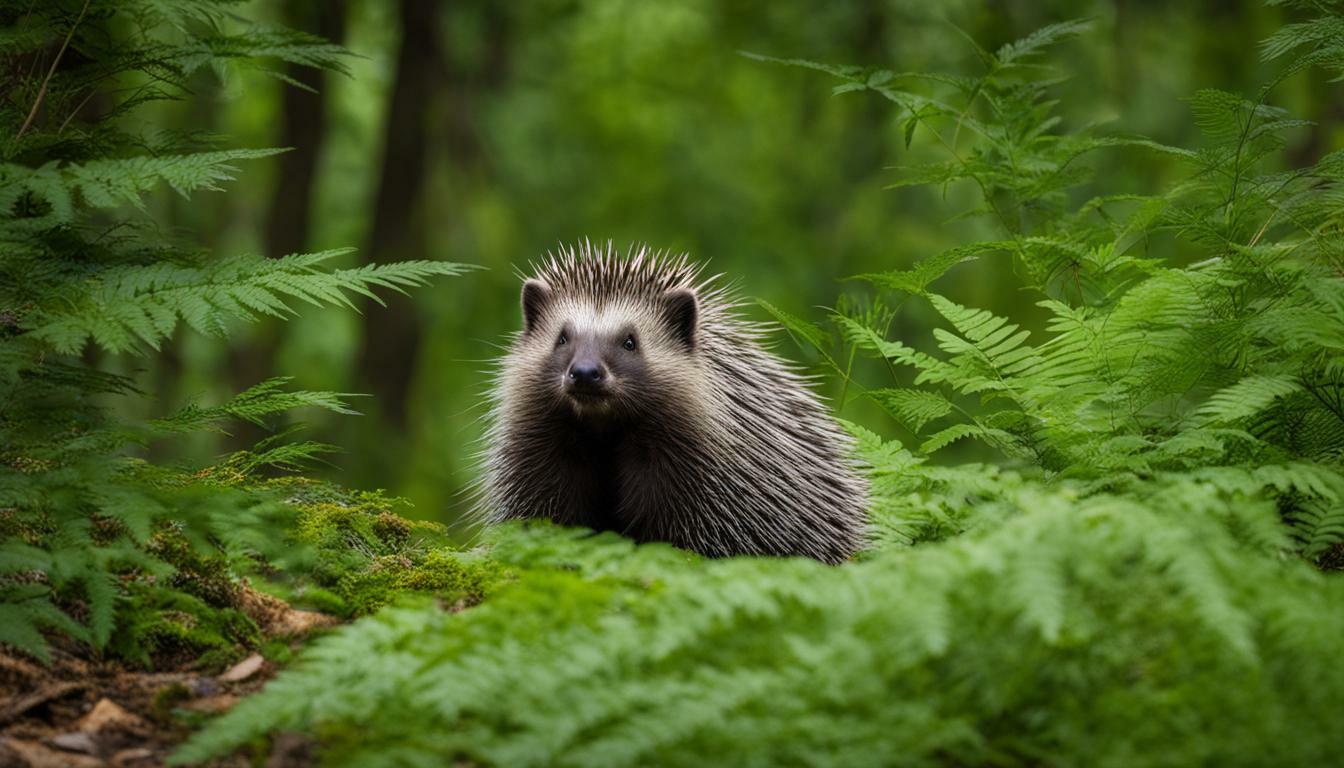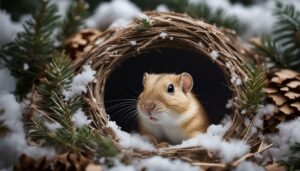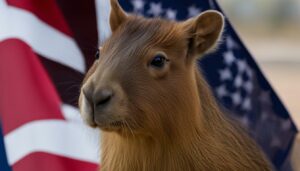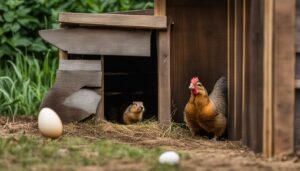Kentucky is known for its diverse wildlife, but are porcupines among the species found in the state?
Porcupines have occasionally been sighted in Kentucky, although there is currently no evidence of a breeding population. Most sightings have been reported in counties bordering Indiana. While specific information about the presence of porcupines in Kentucky is limited, the state boasts a rich variety of wildlife, including rabbits, squirrels, foxes, raccoons, opossums, woodchucks, bats, and rodents.
Key Takeaways:
- Porcupines have been sporadically sighted in Kentucky, but no breeding population has been confirmed.
- Sightings have predominantly occurred in counties bordering Indiana.
- Kentucky is home to a diverse range of wildlife, including rabbits, squirrels, foxes, raccoons, opossums, woodchucks, bats, and rodents.
Porcupine Habitat and Distribution
Porcupines are primarily found in wooded areas, but what is their preferred habitat and distribution in Kentucky? While specific information on the presence of porcupines in Kentucky is limited, there have been occasional sightings reported. However, there is no evidence of a breeding population within the state. Most of these sightings have occurred in counties bordering Indiana.
In general, porcupines prefer forests and woodlands that provide ample vegetation and shelter. They are known to inhabit a variety of forest types, including coniferous forests, mixed hardwood forests, and even shrublands. Porcupines are adept climbers and are often found in trees, where they feed on the bark, twigs, and leaves. They have a preference for areas with a dense canopy cover and plenty of vegetation.
While porcupines are adaptable and can survive in different habitats, their distribution in Kentucky may be influenced by factors such as food availability, suitable den sites, and proximity to suitable habitat. It is important to note that porcupines are known to have a relatively low population density, which could explain their sporadic presence in the state.
Kentucky is home to a diverse range of wildlife, including rabbits, squirrels, foxes, raccoons, opossums, woodchucks, bats, and rodents. The presence of these various species suggests that the habitat conditions in Kentucky are suitable for supporting a diverse array of wildlife. While the exact extent of porcupine distribution in Kentucky remains uncertain, the state’s diverse wildlife habitat provides the potential for porcupines to exist within suitable areas.
| Possible Porcupine Habitat | Porcupine Distribution |
|---|---|
| Forests and woodlands | Occasional sightings in counties bordering Indiana |
| Coniferous forests | N/A |
| Mixed hardwood forests | N/A |
| Shrublands | N/A |
In conclusion, while porcupines are primarily found in wooded areas, their preferred habitat and distribution in Kentucky are not well-documented. Occasional sightings have been reported in counties bordering Indiana, but there is no evidence of a breeding population. Kentucky’s diverse wildlife habitat, including forests and woodlands, provides potential suitable areas for porcupines, but further research and monitoring are necessary to determine their exact presence and behavior within the state.
Porcupine Sightings in Kentucky
While porcupines are not commonly seen in Kentucky, there have been occasional sightings reported. According to available data, these sightings have mainly occurred in counties bordering Indiana. Although there is no evidence of a breeding population in the state, these sporadic encounters suggest that porcupines may occasionally venture into Kentucky’s habitats.
Kentucky is home to a diverse range of wildlife, including rabbits, squirrels, foxes, raccoons, opossums, woodchucks, bats, and various rodents. While information specifically about porcupine presence in Kentucky is limited, the existence of these other species indicates the potential for ecological diversity and the coexistence of different wildlife populations.
As further research and monitoring efforts continue to expand our knowledge of Kentucky’s wildlife, it is important to remain vigilant and report any porcupine sightings to local authorities or wildlife organizations. By contributing to the collective understanding of porcupine distribution in the state, individuals can play a role in ongoing conservation and management efforts.
| Notable Wildlife Species in Kentucky |
|---|
| Rabbits |
| Squirrels |
| Foxes |
| Raccoons |
| Opossums |
| Woodchucks |
| Bats |
| Various Rodents |
By appreciating and understanding Kentucky’s wildlife diversity, we can foster a greater appreciation for the delicate balance of nature and the important role each species plays in the local ecosystem. While porcupines may be elusive in Kentucky, their occasional presence serves as a reminder of the intricate web of life that exists within our natural surroundings.
Porcupine Population in Kentucky
Due to limited sightings, it is unclear if porcupines have established a breeding population in Kentucky. The majority of porcupine sightings in the state have been reported in counties bordering Indiana. While specific information on the presence of porcupines in Kentucky is scarce, the state boasts a diverse range of wildlife, including rabbits, squirrels, foxes, raccoons, opossums, woodchucks, bats, and rodents.
Despite occasional porcupine sightings, there is no evidence to suggest a sustainable population of porcupines in Kentucky. This could be due to various factors such as habitat suitability, limited dispersal, or a lack of suitable food sources for population growth. Porcupines typically require a mix of forested areas and open spaces with an abundance of vegetation to thrive.
To better understand the presence and potential population of porcupines in Kentucky, ongoing research and monitoring efforts are necessary. These initiatives can provide valuable insights into the ecological role of porcupines and their impact on the state’s diverse ecosystem. By studying porcupine behavior, habitat preferences, and population trends, researchers can contribute to wildlife management practices that promote the conservation of these intriguing creatures.
| Wildlife Species | Presence in Kentucky |
|---|---|
| Rabbits | Common |
| Squirrels | Abundant |
| Foxes | Occasional |
| Raccoons | Common |
| Opossums | Common |
| Woodchucks | Occasional |
| Bats | Abundant |
| Rodents | Common |
While porcupines may not currently have a stable population in Kentucky, their occasional presence adds to the state’s diverse wildlife. As wildlife enthusiasts and researchers continue to explore the natural wonders of Kentucky, it is essential to respect and appreciate the delicate balance of its ecosystems, allowing all species, including porcupines, to thrive in their respective habitats.
Kentucky’s Wildlife Diversity
Although porcupines may be rare in Kentucky, the state boasts a rich biodiversity with various species, such as rabbits, squirrels, foxes, and raccoons. Kentucky’s diverse wildlife population adds to the natural beauty and ecological importance of the region. In addition to these common mammals, the state is also home to a wide range of other fascinating creatures.
One of the notable species found in Kentucky is the American black bear. These majestic animals can be found in the eastern part of the state, particularly in the Appalachian region. Kentucky is also a haven for bird enthusiasts, with over 300 species of birds recorded within its borders. From the charismatic bald eagle to the colorful indigo bunting, birdwatchers will find plenty to admire.
Furthermore, Kentucky’s aquatic ecosystems teem with life, offering habitat to various fish species, including largemouth bass, bluegill, and catfish. The state’s network of rivers and lakes also supports a thriving population of turtles, including the eastern box turtle and the snapping turtle.
| Common Mammals | Birds | Aquatic Life |
|---|---|---|
| Rabbits | Bald Eagle | Largemouth Bass |
| Squirrels | Indigo Bunting | Bluegill |
| Foxes | Red-tailed Hawk | Catfish |
| Raccoons | Eastern Bluebird | Turtles (Eastern Box Turtle, Snapping Turtle) |
These examples barely scratch the surface of Kentucky’s rich animal diversity. From the secretive bobcat to the elusive coyote, there is always a chance to encounter a unique species while exploring the state’s forests, fields, and waterways. Kentucky’s commitment to wildlife conservation, including habitat preservation and sustainable management practices, helps ensure that these creatures continue to thrive for future generations to appreciate and enjoy.
Porcupine Ecology
Understanding the ecological role of porcupines can shed light on their potential effects within Kentucky’s wildlife communities. While there is limited information specific to porcupine ecology in the state, we can draw upon general knowledge of these fascinating creatures. Porcupines are herbivores, primarily feeding on the inner bark, twigs, and leaves of trees, as well as other vegetation. Their strong incisors enable them to gnaw through tough plant material, potentially impacting the growth and survival of certain tree species in their habitat.
Porcupines are also known for their unique defense mechanism – quills. These sharp spines cover most of their body and serve as a deterrent against predators. When threatened, a porcupine will raise its quills, making it difficult and potentially painful for predators to attack. However, despite their formidable defense system, porcupines prefer to avoid confrontation and will typically retreat to the safety of trees if they feel threatened.
Another interesting aspect of porcupine ecology is their ability to adapt to various habitats. While they are commonly associated with forested areas, porcupines can also thrive in rocky terrains and mountainous regions. This adaptability allows them to occupy diverse ecosystems, contributing to the overall biodiversity of an area.
Porcupine Habits and Behaviors
It is important to note that porcupines are mainly nocturnal animals, meaning they are most active during the night. Their nocturnal behavior helps them avoid predators and also allows for more efficient foraging, as they can take advantage of reduced competition for food resources during these hours. During the day, porcupines will retreat to dens located in trees, rock crevices, or other suitable sheltered areas.
Reproduction in porcupines typically occurs in late summer or early fall. Females have a gestation period of approximately 210 days before giving birth to a single offspring, known as a porcupette. These young porcupines are born with soft quills that harden within a few days. They will stay with their mother for several months until they are capable of independent living.
| Predominant Porcupine Species in North America: | Porcupine Distribution: |
|---|---|
| North American Porcupine (Erethizon dorsatum) | Widespread across Canada and the United States (including parts of Kentucky) |
It is worth mentioning that porcupines are not aggressive animals and, if left undisturbed, they pose little threat to humans. However, it is important to exercise caution and maintain a safe distance when encountering porcupines in the wild. Avoid direct contact with their quills, as they can become embedded in the skin and be difficult to remove. Appreciating these unique creatures from a respectful distance allows for a harmonious coexistence with Kentucky’s diverse wildlife.
Porcupine Conservation and Wildlife Management
Wildlife management plays a crucial role in maintaining a healthy ecosystem and supporting the conservation of species like porcupines. In Kentucky, a state known for its diverse wildlife, managing and protecting these unique creatures is of utmost importance.
While there have been occasional sightings of porcupines in Kentucky, there is currently no evidence of a breeding population in the state. Most of the documented porcupine sightings have been reported in counties bordering Indiana, suggesting that these animals may be present in Kentucky as transient individuals.
To ensure the conservation of porcupines and other wildlife species in Kentucky, wildlife management initiatives are implemented. These efforts include creating and maintaining suitable habitats, monitoring populations, and educating the public about responsible wildlife encounters.
Promoting Coexistence
One of the key goals of wildlife management in Kentucky is to promote coexistence between humans and wildlife. This involves raising awareness about porcupines and their behaviors, so that people can better understand and appreciate these unique creatures. By educating the public on how to safely and responsibly interact with porcupines, conflicts can be minimized and the wellbeing of both humans and wildlife can be ensured.
| Porcupine Conservation and Wildlife Management in Kentucky |
|---|
| Creating and maintaining suitable habitats |
| Monitoring populations and conducting research |
| Educating the public about responsible wildlife encounters |
Through these conservation and management efforts, Kentucky aims to maintain a balanced and thriving ecosystem that supports the diverse wildlife found within its borders. While the presence of porcupines in Kentucky may be sporadic, it is important to safeguard their habitat and protect these fascinating creatures for future generations to appreciate and admire.
Kentucky’s Porcupine Research and Monitoring
Researchers in Kentucky are actively studying porcupines to gain a better understanding of their species and ecology within the state. While there is no evidence of a breeding population, occasional sightings of porcupines have been reported, primarily in counties bordering Indiana. These sightings suggest that porcupines may occasionally venture into Kentucky from neighboring areas.
Porcupines are fascinating creatures, and research on their presence and behavior in Kentucky is vital for wildlife management and conservation efforts. By studying porcupines, researchers can gather important data on their habitat, distribution, and potential impact on the ecosystem. This information plays a crucial role in making informed decisions about protecting Kentucky’s wildlife diversity.
Research initiatives focus not only on porcupine sightings but also on understanding their ecological role. Porcupines are herbivores, feeding primarily on tree bark, buds, and other vegetation. Their feeding habits can impact the structure and health of forests and other habitats. By monitoring their consumption patterns and behavior, researchers can gain insights into the ecological balance in Kentucky and make recommendations for sustainable wildlife management.
| Porcupine Research in Kentucky | Focus Areas |
|---|---|
| Habitat and Distribution | Understanding where porcupines are found in Kentucky and their range. |
| Feeding Habits | Investigating the vegetation consumed by porcupines and its impact on the ecosystem. |
| Population Dynamics | Assessing the porcupine population status and identifying factors influencing their numbers. |
| Ecological Impact | Examining the effects of porcupines’ presence on Kentucky’s flora and fauna. |
Through ongoing research and monitoring, scientists aim to contribute valuable knowledge about porcupines and their interactions with Kentucky’s environment. This information will aid in making informed decisions regarding wildlife conservation, habitat management, and overall ecological well-being.
Wildlife Tips for Encountering Porcupines in Kentucky
If you happen to encounter a porcupine in Kentucky, it’s important to know how to safely interact with these creatures. While porcupines are generally docile and non-aggressive, their quills can cause injury if you or your pets get too close. Here are some wildlife tips to help ensure a safe and respectful encounter:
- Maintain a safe distance: Porcupines have a natural defense mechanism – their quills. To avoid getting quilled, it’s crucial to keep a respectful distance of at least 10 feet or more. Remember, porcupines are wild animals and should not be approached or attempted to touch.
- Observe quietly and from a distance: If you spot a porcupine, take the time to observe it from afar. Use binoculars or a camera with a zoom lens to get a better look without getting too close. Avoid sudden movements or loud noises that might startle the porcupine.
- Keep pets on a leash: If you’re walking your dog in an area where porcupines have been sighted, always keep them on a leash. Porcupine quills can cause severe pain and infection if they become lodged in your pet’s skin. It’s best to prevent any potential encounters between your curious pet and a porcupine.
While porcupines are fascinating creatures, it’s important to respect their space and natural behaviors. Remember that porcupines are protected wildlife in Kentucky and should not be harmed or harassed. By following these wildlife tips, you can safely coexist with porcupines and appreciate their presence in our diverse Kentucky ecosystem.
| Wildlife Tip | Description |
|---|---|
| Maintain a safe distance | Keep at least 10 feet away from porcupines to avoid getting quilled. |
| Observe quietly and from a distance | Use binoculars or zoom lenses to observe porcupines without disturbing them. |
| Keep pets on a leash | Prevent potential encounters between your pets and porcupines by keeping them on a leash. |
By following these guidelines, you can ensure a safe and respectful interaction with porcupines in Kentucky’s wilderness. Remember, appreciating wildlife from a distance is the best way to protect both yourself and these fascinating creatures.
Conclusion
While porcupines may be rare in Kentucky, occasional sightings and neighboring counties indicate their potential existence within the state’s wildlife landscape. According to sources, there have been documented encounters with porcupines in Kentucky, especially in counties bordering Indiana. However, there is no evidence of a breeding population in the state.
Despite the scarcity of porcupines, Kentucky is known for its diverse range of wildlife. Alongside rabbits, squirrels, foxes, raccoons, opossums, woodchucks, bats, and rodents, porcupines may play a vital ecological role if they establish a sustainable population. However, more research and monitoring initiatives are necessary to fully understand their presence and behavior in the state.
As conservation efforts continue in Kentucky, it is important for individuals to exercise caution when encountering porcupines or any other wildlife. If you happen to come across a porcupine, it is advisable to keep a safe distance and avoid any direct contact. Porcupines are generally docile creatures, but their sharp quills can cause injury.
In conclusion, while porcupines may not be commonly found in Kentucky, the occasional sightings and proximity to neighboring areas suggest that they may indeed inhabit the state’s wildlife habitat. Further scientific investigation and wildlife management efforts are needed to protect and preserve these intriguing creatures and their potential contribution to Kentucky’s diverse ecosystem.
FAQ
Are there porcupines in Kentucky?
According to available information, there have been occasional sightings of porcupines in Kentucky, but there is no evidence of a breeding population in the state.
Where have most porcupine sightings in Kentucky been reported?
The majority of porcupine sightings in Kentucky have been reported in counties bordering Indiana.
What other wildlife can be found in Kentucky?
Kentucky is known for its diverse range of wildlife, including rabbits, squirrels, foxes, raccoons, opossums, woodchucks, bats, and rodents.




